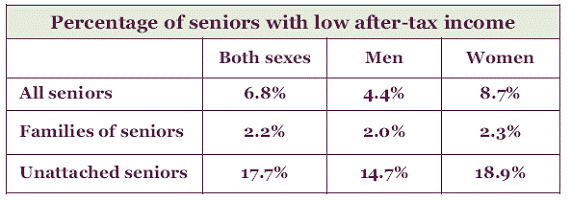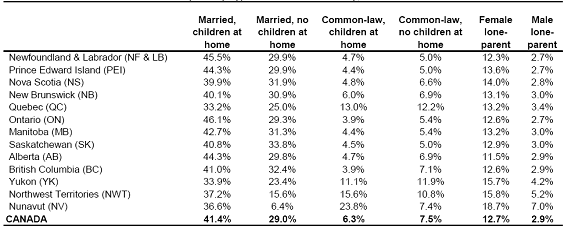FEWO Committee Report
If you have any questions or comments regarding the accessibility of this publication, please contact us at accessible@parl.gc.ca.
Economic security refers to the ability of women and men to plan for future needs and risks and an assurance that basic needs will be met.[6]
There have been significant improvements for low-income women in Canada in recent years. The low-income rate among women has decreased steadily since the mid-90s in all provinces. However, as a witness from Social Development Canada[7], stated, “we still have significant challenges in addressing the gender differences in low income rates, particularly as they affect single senior women, single-parent families headed by women, and women with disabilities.”[8]
The Committee has paid close attention to women belonging to vulnerable groups in society, such as immigrant women, rural women, Aboriginal women, women with disabilities, senior women and single mothers.
2.1. Chronic low income among immigrant women
According to a recent Statistics Canada report, Chronic low-income and low-income dynamics among recent immigrants,[9] close to one-fifth of immigrants who arrived in Canada in the 1990s faced chronic low income, a rate 2.5 times higher than for persons born in Canada. Even after ten years in Canada, immigrants have incomes that are considerably lower than those of persons born in Canada or who have been here for over 10 years.
Figure 2.1. Low-income rates of recent immigrants and the comparison group, aged 20 and over, 1992 to 2004

Source: Statistics Canada, “Chronic Low Income and Low-income Dynamics Among Recent Immigrants”, vol 2007, No. 11-F0019MIF, no.294
Since statistics show that more women than men enter Canada under the family reunification category and are less likely to be the main applicants in the “economic” and “humanitarian” categories, the Committee sought to determine whether male and female immigrants experience chronic low income at the same rate.
Rural women grapple with a complex reality encompassing social and labour market changes which generate uncertainty relating to their income security. The Committee looked at such issues as poverty among rural women and the important role of farm women in Canada.
We are in a catastrophic state in the farm community right now. We have many issues that we have to deal with, not only farm issues but rural issues. That is our context. That’s where we live. That’s our culture and our identity.[10]
In terms of the urban and rural divide, there are interesting distinctions:
Rural senior women tend to have lower incomes than their urban counterparts but are far more likely to be living either with their spouse or with their family. Very few rural senior women live on their own, so that mitigates that situation.[11]
Availability of, and access to, resources are a challenge to the economic security in rural communities. There are also important issues in linking skills with available jobs. Women who at one time or another have had to deal with sudden illness, an accident, a disability, violence or marital problems have been trapped in poverty, especially given the limited options available to escape that poverty.
The Aboriginal peoples of Canada are a diverse group. The Committee heard from women’s representatives from the First Nations, the Métis and the Inuit. Although many Aboriginal women live in poverty, there are also thousands of Aboriginal women who are successful in various fields throughout the country, Aboriginal women have higher levels of education than Aboriginal men. A brief glance at the status of Aboriginal women in Canada demonstrates that, despite gains made by some Aboriginal women, many still confront high levels of poverty and violence:
The percentage of Aboriginal women living in poverty is more than double the percentage of non-Aboriginal women who are poor. At the time of the 2001 Census, based on before-tax incomes, more than 36% of Aboriginal women, compared with 17% of non-Aboriginal women, were living in poverty. Like many other women living in poverty, Aboriginal women are particularly affected by the social assistance policies of provincial and territorial governments. Aboriginal women employed on reserves may not be covered by the Canada Pension Plan.[12]
In 2001, close to 2 million women or 13% of all women in Canada had a disability. The disabled population in Canada is diverse, and the consequences of disability on the individual can vary greatly from one person to the next.
The likelihood of a woman having a disability increases with age. In 2001, 72% of women aged 85 and over had a disability, compared to 50% of women aged 75 to 84 and 32% of women aged 65 to 74. In addition, just over 800,000 women or close to 7% of women aged 15 and over had a severe or very severe disability.[13]
As in the general population, employment levels among women with disabilities increase with levels of education. Among university graduates with a disability, 66% of women and 64% of men were employed in 2001. Women with a disability and a lower education level were somewhat less likely than their male counterparts to be employed. Women with a disability were also less likely to be employed than women without a disability.
The Committee heard that “over the past 25 years, low income among seniors, including female seniors, has been significantly reduced, primarily as a result of the maturation of the Canada Pension Plan.”[14] Women over 65 are still more likely than men of the same age to have low incomes. This is especially true for unattached senior women, 19% of whom have low after-tax incomes.[15]
Figure 2.2 Occurrence of low income among seniors — Canada, 2003

Source: National Advisory Council on Aging, “Aging in Poverty in Canada”, Seniors on the Margins Series, p. 10.
The Committee heard that:
Due to increasing numbers of women who participate in the labour force, it is likely that future cohorts of women will be in a better financial position at retirement. However, women will continue to face unique retirement challenges, including greater life expectancy and continuing expectations to provide care, relative to men.[16]
An official from Human Resources and Social Development stated that among men and women aged 45 to 64, nearly twice as many women change their work arrangements to care for others and are more likely than men to reduce their working hours.[17] The Canadian Teachers Federation noted that a link existed between the economic security of women approaching retirement and elderly care.
We believe that assistance for elder care is a significant component of the economic security of women, particularly in the 40- to 60-year age group.[18]
The majority of the 1.3 million single-parent families in Canada are headed by women (81.3%).[19] In other words, over a million women in Canada were single mothers in 2001. They include Aboriginal, immigrant and disabled women who are single parents.
Low income affects single-parent families in particular. According to Statistics Canada, in 2001, the poverty rate among single mothers under 65 years of age was 42.4%, compared to 19.3% for single fathers, 9.5% for couples with children and 8.1% for couples without children.[20]
Aboriginal women are also much more likely to be single mothers than other women. In 2001, 19% of Aboriginal women aged 15 and over were single mothers, compared to 8% of other women.
Foreign-born women are only slightly more likely than Canadian-born women to head single-parent families and, like Canadian-born women, they are much more likely than their male counterparts to be single parents.
In 2001, 12 per cent of the 1.9 million women aged 15 and over with disabilities were single mothers. In comparison, 3.3 per cent of the 1.5 million men aged 15 and over with disabilities were single parents.[21]
Figure 2.3 Distribution of Canadian Families,
By Family Type and Province/Territory, 2001

Source: Canadian Council on Social Development, “A profile of Canadian families” CCSD’s Stats & Facts: Canadian Families
[6] F/P/T Ministers for the Status of Women, Women’s Economic Independence and Security: A Federal/Provincial/Territorial Strategic Framework, March 2001. http://www.swc-cfc.gc.ca/pubs/0662655427/200103_0662655427_e.html#purpose.
[7] This department has since been amalgamated into Human Resources and Social Development Canada, (HRSDC).
[8] Deborah Tunis (Social Development Canada), Evidence, June 8, 2007.
[9] Statistics Canada. Chronic low-income and low-income dynamics among recent immigrants. By Garnett Picot, Feng Hou and Simon Coulombe, Catalogue no. 11F0019MIE, no. 294, Ottawa, p. 5 and 17.
[10] Karen Fyfe, National Women’s Vice-President, National Farmers Union, Evidence, March 29, 2007.
[11] Colin Lindsay, Statistics Canada, Evidence, February 15, 2007.
[12] Status of Women Canada, Poverty Issues for Canadian Women, Monica Townson, August 2005.
[13] Statistics Canada, Women in Canada: A Gender-based Statistical Report, 2005. p.12.
[14] Susan Scotti, Social Development Canada, Evidence, June 8, 2006. (Social Development Canada was amalgamated with Human Resources and Social Development Canada.)
[15] Statistics Canada, Women in Canada: A Gender-based Statistical Report, 2005, (89 503 XPF), pp. 143-144.
[16] Susan Scotti, Social Development Canada, Evidence, June 8, 2006.
[17] Statistics Canada, Women in Canada: A Gender-based Statistical Report, 2006.
[18] Canadian Teachers Federation, Evidence, May 8, 2007.
[19] Deborah Tunis, Social Development Canada, June 8, 2006.
[20] Sylvie Lévesque, Director General, Fédération des associations de familles monoparentales et recomposées du Québec, Evidence, March 22, 2007.
[21] Statistics Canada Women in Canada: A Gender-based Statistical Report, 2005, table 12.3, p. 303.